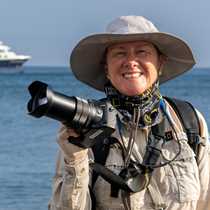Astoria
As we cruised into Astoria, the clear skies of earlier became shrouded in a low fog bank that didn't quite reach the shores of town but wrapped itself around an oil tanker coming up river, possibly headed for Portland. Fog horns blew as we stepped off the ship and onto the dock. The bite of the clear, cold air caught us crossing the plaza to the warm reception of the Maritime Museum. We were captivated by the displays and interpretation until time ran out and it was time to head up. Literally. The buses drove up an incredible incline to deposit us at the base of the famous Astoria Column. Built in 1926 and restored a couple times, the frieze that winds around the column in a rising spiral tells the story of this extraordinary part of the country. Today was extraordinary. We had a practically panoramic view around us, and Tom McAllister, our ship's Historian, pointed out all the landmarks used by Lewis and Clark that we could see – which were quite a few. Linda Burback, our ship's naturalist, led a walk down from the heights into the town, passing by a black-tailed tail hidden in the brush, yet seen by those of us still up above.
The afternoon found us visiting Fort Clatsop where Lewis and Clark and the Corps of Discovery spent a miserable winter from 1804-1805. Who would have thought! Today the sun shone brightly, the trees and under-story shone green, and the crisp weather delighted everyone. Today was an exception, the norm lately being plenty of humidity (read: rain), and this year the mushroom season has been phenomenal, according to the Fort Clatsop rangers. A challenge to photograph for their diminutive size, these "pixie parasols" appealed to Linda as irresistible subjects for today's report. The mushrooms here have evolved over the eons and are well-adapted to the wet environment, and survival isn't an issue. For the Corps of Discovery, mushrooms, mold and the damp were their worst enemy. It brought depression, spoiled foodstuffs and rotted clothing. Our ranger today used a great analogy to describe the amount of meat eaten by the men during their times of greatest hardship and labor. They ate eight pounds of meat daily (when they had it), the equivalent of 30 hamburgers, hold the cheese, lettuce, tomatoes, pickles, buns and sauces. Now make half the meat patties green. Today we can look at these "pixie parasols" and appreciate them for their esthetic beauty. For the Corps of Discovery however, they were probably just symbolic of the depressing wetness of the region and the trials of survival.
In the late afternoon we returned to the Sea Lion and set out for the infamous Columbia River "bar." Not Kevin's bar in the lounge, however, but the rolling breakers protecting the mouth of the river. We approached, yet didn't cross. We rolled, but not uncomfortably. The rosy light caught the gulls and pelicans around us, as they fished the last light.
As we cruised into Astoria, the clear skies of earlier became shrouded in a low fog bank that didn't quite reach the shores of town but wrapped itself around an oil tanker coming up river, possibly headed for Portland. Fog horns blew as we stepped off the ship and onto the dock. The bite of the clear, cold air caught us crossing the plaza to the warm reception of the Maritime Museum. We were captivated by the displays and interpretation until time ran out and it was time to head up. Literally. The buses drove up an incredible incline to deposit us at the base of the famous Astoria Column. Built in 1926 and restored a couple times, the frieze that winds around the column in a rising spiral tells the story of this extraordinary part of the country. Today was extraordinary. We had a practically panoramic view around us, and Tom McAllister, our ship's Historian, pointed out all the landmarks used by Lewis and Clark that we could see – which were quite a few. Linda Burback, our ship's naturalist, led a walk down from the heights into the town, passing by a black-tailed tail hidden in the brush, yet seen by those of us still up above.
The afternoon found us visiting Fort Clatsop where Lewis and Clark and the Corps of Discovery spent a miserable winter from 1804-1805. Who would have thought! Today the sun shone brightly, the trees and under-story shone green, and the crisp weather delighted everyone. Today was an exception, the norm lately being plenty of humidity (read: rain), and this year the mushroom season has been phenomenal, according to the Fort Clatsop rangers. A challenge to photograph for their diminutive size, these "pixie parasols" appealed to Linda as irresistible subjects for today's report. The mushrooms here have evolved over the eons and are well-adapted to the wet environment, and survival isn't an issue. For the Corps of Discovery, mushrooms, mold and the damp were their worst enemy. It brought depression, spoiled foodstuffs and rotted clothing. Our ranger today used a great analogy to describe the amount of meat eaten by the men during their times of greatest hardship and labor. They ate eight pounds of meat daily (when they had it), the equivalent of 30 hamburgers, hold the cheese, lettuce, tomatoes, pickles, buns and sauces. Now make half the meat patties green. Today we can look at these "pixie parasols" and appreciate them for their esthetic beauty. For the Corps of Discovery however, they were probably just symbolic of the depressing wetness of the region and the trials of survival.
In the late afternoon we returned to the Sea Lion and set out for the infamous Columbia River "bar." Not Kevin's bar in the lounge, however, but the rolling breakers protecting the mouth of the river. We approached, yet didn't cross. We rolled, but not uncomfortably. The rosy light caught the gulls and pelicans around us, as they fished the last light.




